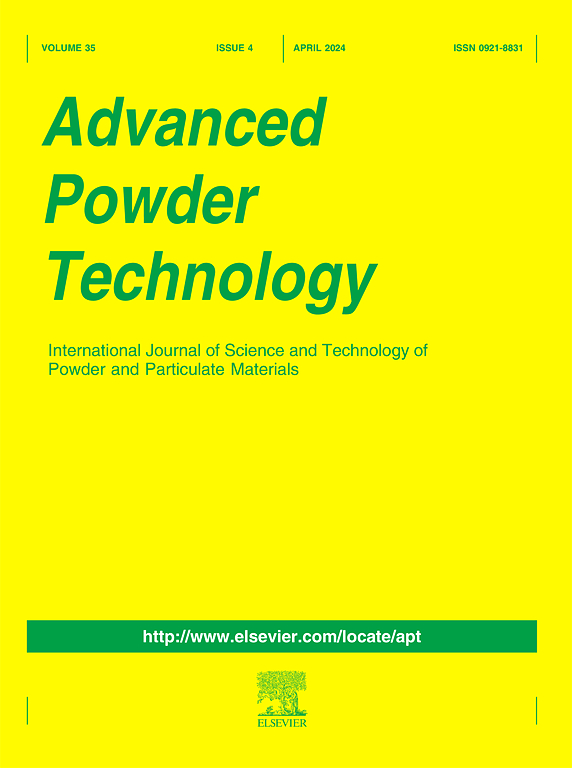小颗粒混合系统中主颗粒相互作用力与压实堆积率的关系分析
IF 4.2
2区 工程技术
Q2 ENGINEERING, CHEMICAL
引用次数: 0
摘要
通过在主颗粒中掺入较小的颗粒,可以提高颗粒床充填率。然而,堆积率这一宏观性质与颗粒床中粒子相互作用力这一微观性质之间的关系还有待充分阐明。在本研究中,测量了不同掺合颗粒混合质量比下样品的压实堆积率。此外,根据颗粒床的抗剪强度计算了主要颗粒之间的相互作用力,并考察了相互作用力与压实堆积率的关系。相互作用力随混合颗粒质量比的变化取决于施加在颗粒床上的法向应力。这一结果可以解释为当颗粒床中的颗粒在外力作用下移动时,其受法向应力的约束状态不同。这些结果对于预测掺有较小颗粒的颗粒床的压实堆积特性是有用的。本文章由计算机程序翻译,如有差异,请以英文原文为准。

Analysis of the relationship between main particle interaction force and compacted packing fraction in a smaller particle admixing system
Particle bed packing fraction can be improved by admixing smaller particles with the main particles. However, the relationships of the packing fraction, which is a macroscopic property, with the particle interaction force in the particle bed, which is a microscopic property, remain to be fully elucidated. In this study, the compacted packing fraction was measured for samples with different mixing mass ratios of admixed particles. In addition, the interaction forces between main particles were calculated from the shear strength of the particle bed and the correlation between the interaction forces and the compacted packing fraction were examined. The change in the interaction force with the mixing mass ratios of admixed particles depended on normal stress applied to the particle bed. This result was explained by the different confined state of the particle bed, which were confined differently by the normal stress when the particles in the particle beds were moved by external forces. These results are useful for predicting the compacted packing properties of particle beds with smaller admixed particles.
求助全文
通过发布文献求助,成功后即可免费获取论文全文。
去求助
来源期刊

Advanced Powder Technology
工程技术-工程:化工
CiteScore
9.50
自引率
7.70%
发文量
424
审稿时长
55 days
期刊介绍:
The aim of Advanced Powder Technology is to meet the demand for an international journal that integrates all aspects of science and technology research on powder and particulate materials. The journal fulfills this purpose by publishing original research papers, rapid communications, reviews, and translated articles by prominent researchers worldwide.
The editorial work of Advanced Powder Technology, which was founded as the International Journal of the Society of Powder Technology, Japan, is now shared by distinguished board members, who operate in a unique framework designed to respond to the increasing global demand for articles on not only powder and particles, but also on various materials produced from them.
Advanced Powder Technology covers various areas, but a discussion of powder and particles is required in articles. Topics include: Production of powder and particulate materials in gases and liquids(nanoparticles, fine ceramics, pharmaceuticals, novel functional materials, etc.); Aerosol and colloidal processing; Powder and particle characterization; Dynamics and phenomena; Calculation and simulation (CFD, DEM, Monte Carlo method, population balance, etc.); Measurement and control of powder processes; Particle modification; Comminution; Powder handling and operations (storage, transport, granulation, separation, fluidization, etc.)
 求助内容:
求助内容: 应助结果提醒方式:
应助结果提醒方式:


